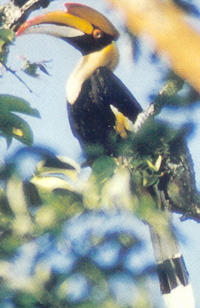 'I believe any trip in search of wildlife can be coupled with physical activity and elements of cultural diversity to form a thrilling opportunity ' 'I believe any trip in search of wildlife can be coupled with physical activity and elements of cultural diversity to form a thrilling opportunity '
John H.Eickert |
CHEER her! CHEER her! While stopped at a forest fringe for lunch in Manas National Park I was startled by the whoosh of large feathered wings and then that loud obvious call. Both of my guides laughed at my reaction. I produced
a piece of paper and asked one of them to draw the bird which had produced the call. It was my first time solo in India, neither of my guides spoke English, but we managed to communicate using drawings and hand signals. He drew a Greater Indian Pied Hornbill,
and I am sure I still have the sketch, somewhere. We ate our lunch and then walked up into the forest near the border with Bhutan hoping to find the feeding station or nest of the bird that had called.
 That day we did not find the bird or hear it's call again, but I have seen them in peninsular India and in two other Asian countries. Hornbills are fascinating birds. They feed on fig and nutmeg. Both trees depend on the hornbill
to spread their seeds. Hornbills are found in most wet forests through Asia, but are not related to the similar toucan of South America. The hornbill once had a broad natural range, but now is becoming rare. Hornbill's nest in the hollow's of old or dead trees,
usually fig. The female builds a nest in the tree cavity then the male seals up the nest area with mud. The female remains in the enclosure until the young are ready and then both adults break down the wall. What a great adaptation to ward off predators during
nesting! Ah, but this may also prove to be the downfall of the species. Logging has increased throughout their range. Fewer older trees mean fewer hollow trees. The hornbills are dependent on old growth forest for their survival.
That day we did not find the bird or hear it's call again, but I have seen them in peninsular India and in two other Asian countries. Hornbills are fascinating birds. They feed on fig and nutmeg. Both trees depend on the hornbill
to spread their seeds. Hornbills are found in most wet forests through Asia, but are not related to the similar toucan of South America. The hornbill once had a broad natural range, but now is becoming rare. Hornbill's nest in the hollow's of old or dead trees,
usually fig. The female builds a nest in the tree cavity then the male seals up the nest area with mud. The female remains in the enclosure until the young are ready and then both adults break down the wall. What a great adaptation to ward off predators during
nesting! Ah, but this may also prove to be the downfall of the species. Logging has increased throughout their range. Fewer older trees mean fewer hollow trees. The hornbills are dependent on old growth forest for their survival.
In India , the hornbill can be found in the Western Ghats and much of forested Assam . I have not been into Meghalaya, but have been told the hornbill is common there. Perhaps there, in ‘the abode of the clouds' the hornbill has a stronghold
in that wettest of wet places. I hope so. Meghalaya then would be the best place for an adventure to view hornbills in the wild. I would think the best time would be as the female bird emerges from the nest and joins the male in feeding the young. This period
would create greater activity, which could lead to greater viewing opportunities.
They really are an impressive bird. I have been told they are known to eat squirrels, but do not know if this is true. I hope they survive. You might say I am cheering for their survival the same way that first hornbill cheered for me
during a lunch stop those many years ago in Manas.
I hope all of you, my friends, are well and those who celebrate it have enjoyed the festival of Diwali, the fireworks and new clothes. Cheers.
( Picture of Great Pied Hornbill from Birds of Western Ghats , Konkan and Malabar, by Satish Pande published by BNHS, Mumbai)
Visit http://www.numbum.net or call NumBum Adventurers at 406-777-2228